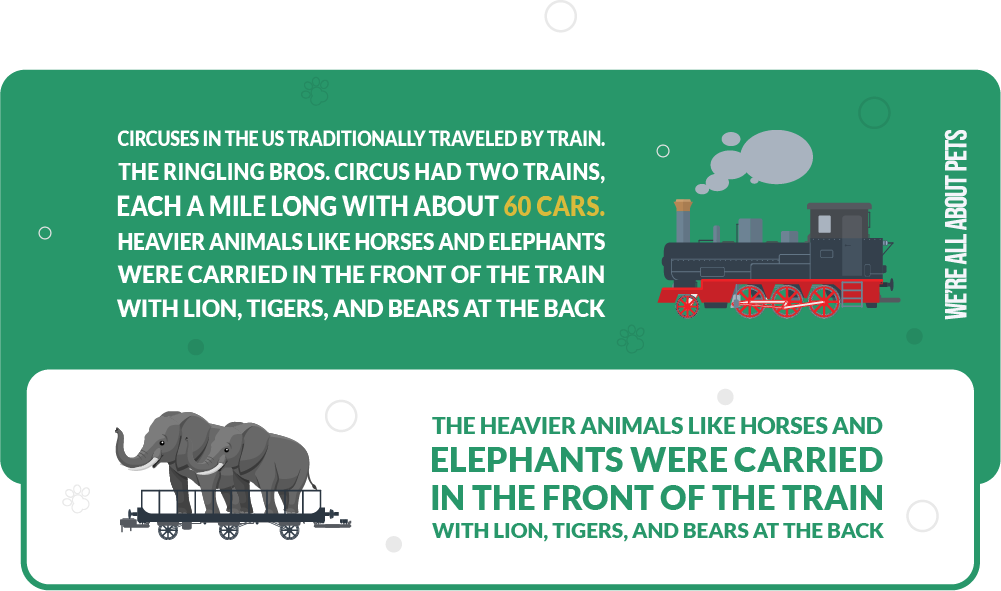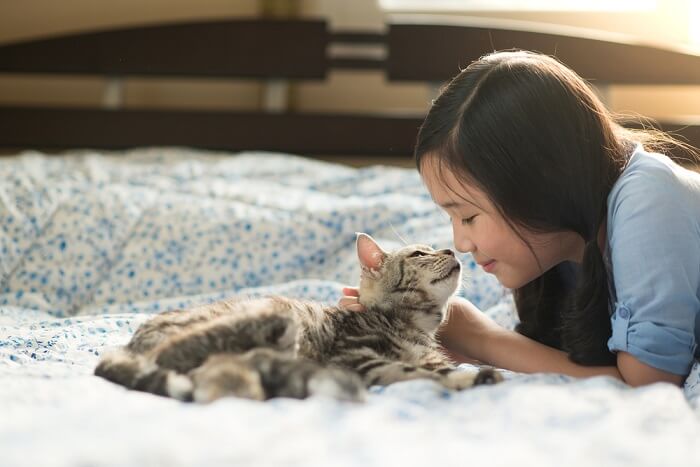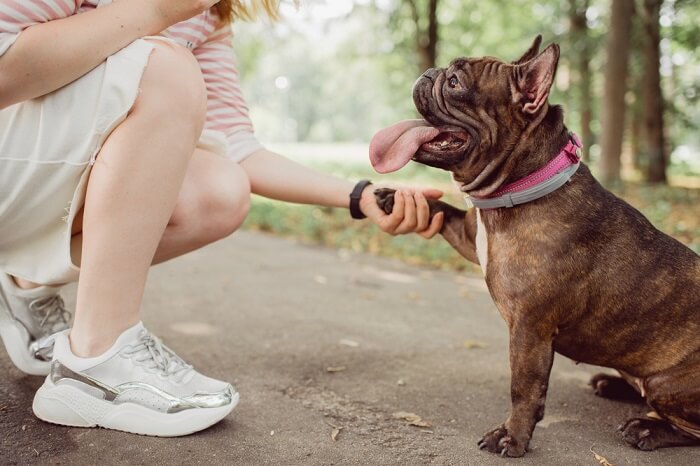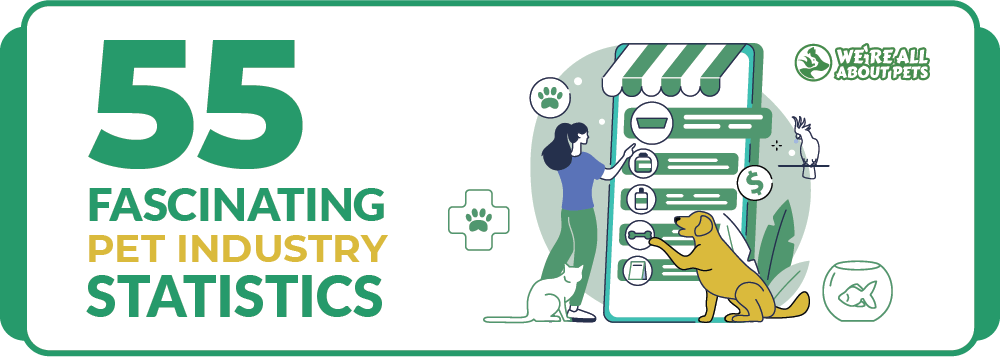55 Powerful Circus Animal Abuse Statistics
This page contains affiliate links. We may earn money or products from the companies mentioned in this post through our independently chosen links, which earn us a commission. Learn More

You won’t find tigers jumping through fiery hoops in the wild or bears riding bicycles. Wild elephants don’t walk around on two legs and wild sea lions don’t balance balls on their noses for fun.
These are the kinds of animal acts you may have seen at the circus during your youth. Though the traveling circus is not what it once was, there are still countless stories of animal mistreatment and abuse around the world stemming from these shows.
The animals used in circus acts vary from one company to another but may include big cats (primarily lions, tigers, and leopards), horses, donkeys, elephants, zebras, bears, monkeys, and sea lions among domesticated animals like dogs and cats.
In the early years of the circus, animals were displayed in a menagerie. The first true animal acts that appeared in circus shows were equestrian (horse) acts. These were followed by elephants and big cats.
More recently, animal rights groups have fought to eliminate animal acts from circuses. People for the Ethical Treatment of Animals (PETA) claims that circus animals are frequently punished and beaten into submission. There are numerous reports of physical abuse being used as a training method for circus animals, not to mention the horrible conditions in which the animals are kept.
Several organizations have conducted investigations into the welfare of circus animals and many circuses have stopped using wild animals. Read on to see some shocking statistics about this subject.
Check out our powerful circus animal abuse statistics infographic and keep reading to learn more!
12 Facts About The History Of Circuses In The United States
In Ancient Rome, the term “circus” referred to a building dedicated to the exhibition of horse races, chariot races, tagged battles, equestrian shows, and gladiatorial combat.
The format for the modern circus has been attributed to Philip Astley, an English cavalry officer who set up a modern amphitheater to display horse riding tricks in London in 1768. Englishman John Bill Ricketts is credited with bringing the modern circus to the United States.
- The circus was revolutionized in the 1800s when P.T. Barnum and William Cameron Coup launched the first traveling circus, P.T. Barnum’s Museum, Menagerie & Circus.
- The first modern circus opened in the United States in Philadelphia by Englishman John Bill Ricketts in 1973.
- The Ringling Bros. and Barnum & Bailey Circus, billed as The Greatest Show on Earth, ran from 1871 to 2017. After 1957, the circus performed under portable “big top” tents rather than using permanent venues.
- Circuses in the United States traditionally traveled by train. The Ringling Bros. circus had two trains, each a mile long with about 60 cars. The heavier animals like horses and elephants were carried in the front of the train with lions, tigers, and bears at the back.

- It’s difficult to estimate the current number of circuses in the U.S., but it was as high as 12,000 at one point. Animal Defenders International (ADI) estimates that there are currently around 300 wild or exotic animals currently in U.S. circuses.
- Every major circus that uses wild animals in the United States has been cited for violating the minimal standards of care set forth by the U.S. Animal Welfare Act (AWA).
- In 1998, The USDA filed charges against Ringling Bros. for forcing a sick elephant to perform. The circus paid a $20,000 fine.

- In 2000, the American Society for the Prevention of Cruelty to Animals (ASPCA) along with other animal rights groups sued Ringling Bros. circus, alleging their treatment of Asian elephants violated the Endangered Species Act.
- In 2004, Ringling Bros. was investigated after one of their lions (a 2-year-old male named Clyde) died from heatstroke as the train was traveling across the Mojave Desert. This case was just one battle in an ongoing war between circuses and animal rights groups.
- The USDA conducted inspections of Ringling Bros. animals and facilities between 2007 and 2011. These inspections revealed numerous counts of non-compliance with the agency’s regulations which, combined with complaints filed by PETA, resulted in the circus paying the largest civil penalty ($270,000) ever assessed against an animal exhibitor under the Animal Welfare Act.
- In 2015, the circus’ parent company (Feld Entertainment) vowed to stop using elephants in its shows by 2018. They stated the 13 elephants that were currently part of the show would be sent to the circus’ Center for Elephant Conservation.
- The circus’ final performance with elephants occurred on May 1, 2016 in Wilkes-Barre, PA with one unit and in Providence, RI for the circus’ second unit.
8 Shocking Circus Animal Facts And Statistics
- Circus animals spend 11 months of the year traveling in box cars with no climate control, often eating, sleeping, and defecating all in the same cage.
- Roughly 96% of a circus animal’s life is spent in a cage or in chains.

- Large cats, typically lions and tigers, are kept in beast wagons – small mobile cages where the animals spend most of their time. Some may have access to exercise cages, but they are often only slightly larger than the beast wagon.
- Since 2000, more than 35 instances have been recorded of circus elephants running amok in the streets. Some have attacked members of the public and injured or killed their handlers.
- Between 1994 and 2005, more than 30 elephants have died prematurely in circuses. Horses and lions are also at the top for untimely deaths.
- An undercover investigation by Freedom for Animals in 2009 revealed that elephants at the Great British Circus were chained for up to 11 hours per day.
- Tigers are naturally afraid of fire but, in circus shows, are often forced to jump through hoops of fire, sometimes being burned while doing so.

- During the off-season, circus animals are typically housed in small traveling crates. Confinement of this kind has been known to induce harmful psychological effects on the animals.
5 Statistics From A 2008 Investigation
In 2008, researchers at Wageningen University conducted an investigation into the welfare of circus animals on behalf of the Ministry of Agriculture, Nature, and Food Quality of the Netherlands. Based on these findings, the Dutch government announced a ban on the use of wild animals in circuses in 2012.
Here are some statistics revealed in their report:
- One-third (33%) of the lions and tigers did not have access to an outdoor enclosure. The lions spent 98% of their time indoors.
- The average size of tiger enclosures was only about 5 square meters. In the wild, a male tiger’s territory ranges from 60 to 100 square kilometers.
- The majority of observed animals (71%) had medical problems.
- The elephants were chained for 17 hours per day, on average. These elephants also spent an average of 10 hours per day showing stereotypic behavior (repetitive, abnormal behaviors that have no obvious function).
- Since 1990, there have been over 123 cases of lion attacks occurring at circuses.

15 Stories Of Circus Animal Escapes And Attacks
- In 1992, an elephant named Janet went out of control during a performance of the Great American Circus in Palm Bay, FL. Janet stampeded through the circus grounds before being shot to death by local police.
- During a 1994 Circus International performance in Honolulu, Hawaii, an elephant named Tyke killed her trainer and mauled her groomer. The elephant then bolted from the area and ran loose for more than 30 minutes before being shot to death by police. She’d been shot 86 times.
- In 2006, a lifelong animal trainer suffered serious injuries to the leg and hand in a clawing by a tiger during a performance at Hadi Shrine Circus in Indiana.
- In March 2008, three zebras from the Ringling Bros. Circus escaped from their temporary enclosures and ran into traffic in Baltimore, MD.
- A spider monkey named Reggie escaped from the Liebling Family Circus in Fruitland Park, FL in March 2009.

- In Indianapolis, IN, an elephant bolted when being used to give rides at the Murat Shrine Circus in March 2009. At least 15 children and one adult were injured when the elephant startled, knocking over the scaffolding leading to the ride.
- In February 2010, a startled elephant made a wrong turn backstage and broke through a prop door into a room housing 100 pre-show spectators at a Ringling Bros. circus in Columbia, SC.
- Two weeks later, a zebra escaped from the same circus during a performance in Atlanta. The zebra ran into the city and was eventually captured on a busy interstate. The animals were later euthanized.
- In November 2009, an elephant escaped from the Family Fun Circus in Enid, OK and was struck by a vehicle on U.S. Interstate 81.
- An animal handler was killed during a performance with Hamid Circus in Wilkes-Barre, PA in April 2010. The handler was kicked and throw about 20 feet by an African elephant named Dumbo. The handler later died of his injuries.
- In April 2010, an elephant named Viola bolted from Cole Bros. Circus. While on the loose for about 30 minutes, she injured her shoulder and broke a toenail when she slid in the mud and fell into a ravine.
- In April 2012, an elephant trainer was hospitalized for crush injuries after trying to break up a fight between two elephants at the Courtney Bros. Circus in Cork, Ireland. Just a few days earlier, a baby elephant had escaped from the same circus and ran through the parking lot.
- In November 2012, a Cole Bros. Circus truck carrying elephants crashed into a Mississippi ditch. Rescue workers had to use the Jaws of Life to remove animals from the wreckage.
- Three circus elephants were left out in the cold on a snow-covered Interstate 70 in Indiana when their Hanneford Circus trailer slid off the road.

- In April 2013, a tiger escaped during a performance of the Isis Shrine Circus in Salina, KS. A circus patron reportedly came face-to-face with the tiger in a bathroom after the circus staff was unable to immediately recapture the cat.
10 Circus Animal Laws And Bans
- In 2012, the Dutch government announced a ban on the use of wild animals in circuses.
- In England, a law was due to be passed banning the use of wild animals in circuses by the end of 2015. Unfortunately, Conservative MP Christopher Chope blocked the bill, stating that the bill was “at the bottom of the list” in terms of importance.
- On May 1, 2019, Environmental Secretary Michael Gove announced a new bill to ban the use of wild animals in circuses.
- At least 35 countries have invoked nationwide bans on the use of some, if not all animals in circuses. Some of these countries include Austria, Belgium, Croatia, Czech Republic, Denmark, Finland, Greece, Hungary, Ireland, Malta, Netherlands, Peru, and Switzerland.

- In at least 9 other countries, there are local restrictions or bans on the use of animals in entertainment. These include Australia, Argentina, Brazil, Canada, Chile, Germany, Spain, the United Kingdom, and the United States.
- In Germany, a 2008 accident with an elephant that occurred during a circus performance prompted calls for a ban on animal performances in circuses.
- In the United States, city ordinances banning performances by wild animals have been enacted in several major cities including Los Angeles, San Francisco, and New York City.
- Greece became the first European country to ban all animal performances in circuses in February 2012. This came in the wake of a campaign run by the Greek Animal Welfare Fund (GAWF) and Animal Defenders International (ADI).
- In 2015, the Federation of Veterinarians of Europe released a position paper in which they recommended the prohibition of using wild animals in traveling circuses.
- Though many modern circuses have moved toward an emphasis on human performance, traditional circus companies that feature animal performances still exist. Here are a few of the big players: Big Apple Circus (U.S.), Circus Krone (Munich), Lennon Bros. Circus (Australia), Vazquez Hermanos Circus (Mexico), and Moira Orfei Circus (Italy).









